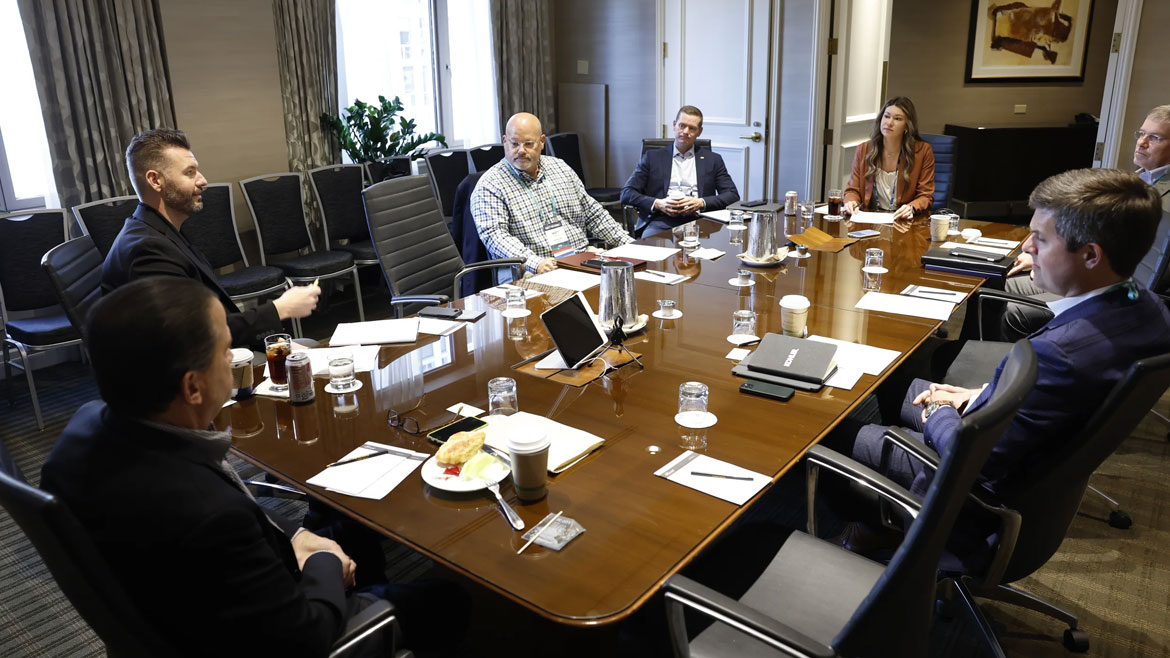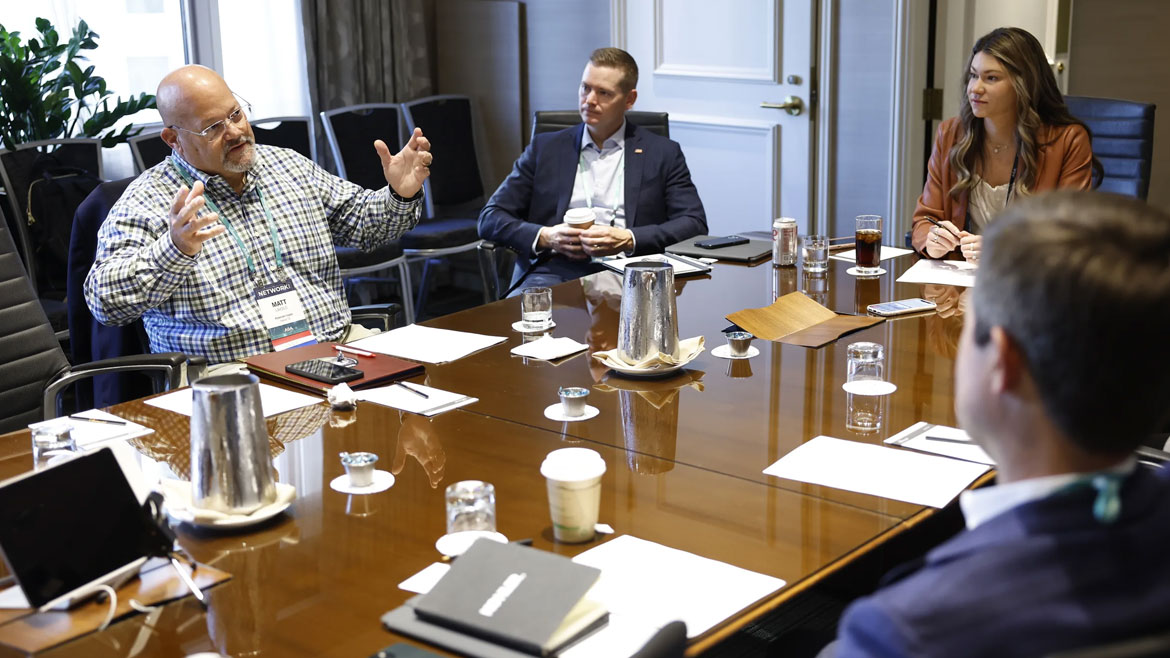During each annual American Supply Association (ASA) NETWORK event it is evident that the most valuable learning opportunity for PHCP-PVF wholesale-distributors is the chance to talk directly with industry peers about challenges, solutions, ideas and innovations. There are plenty of opportunities built into NETWORK — which boasted a record 850 attendees in Chicago this past November — designed to spark this type of conversation. In addition to that, for the past 13 years, ASA has recommended a handful of distributors from across the country to participate in a roundtable discussion with Supply House Times to get a direct pulse for the state of distribution. Below is part one of the conversation. Part two will be published in the February 2023 issue. The 2022 roundtable participants were:
Anderson Hill, senior vice president, sales for Nashville, Tennessee-based Kenny Pipe and Supply;
Keith Hubbard, president and CEO at Santa Rosa, California-based PACE Supply;
Matt Laiolo, president of Oakland, California-based Rubenstein Supply;
Tom Murphy, CEO of Santa Ana, California-based Ace Stainless Supply; and
David Price, president and CEO of Wilson-North Carolina-based, Ihrie Supply Company
During the roundtable, participants covered everything from supply chain and labor concerns to working with the next generation customer and warehouse technology. One thing is for certain, the distribution game has changed.
PERFORMANCE AND SUPPLY CHAIN
One thing that hasn’t changed from the past couple of years is that despite uncertainty and ongoing supply chain challenges, PHCP-PVF wholesaler-distributors experienced positive growth, demand and overall performance in 2022. This group of participants agreed that diversification has been instrumental to achieving record growth.
“This year has been strong,” PACE’s Hubbard said. “We had to wrap our minds around actual unit sales to account for inflation, but we still experienced double-digit growth. A key driver for us was single family housing, but as that has begun to trail off later in the year, our other divisions such as multifamily, underground waterworks and other specialty divisions were strong and augmented the cooling residential new construction market.”
Laiolo agreed that diversification was a key driver to success for Rubenstein Supply this year. “Our showroom that opened six years ago has really performed well for us,” he said. “We’ve always been a plumbing service and repair oriented company but dabbling in other markets like HVAC and new construction helped us experience growth in recent years.”

Again proving the importance of diversification, Murphy noted Ace Stainless is forecasting 40-60% growth in 2023. “We’re very diverse in terms of our client base — we serve OEMs, MROs, industrial, mechanical and some plumbing — this diversity and our amazing team is why I think we’re able to expect such aggressive growth next year.”
Over in Tennessee, Hill said Kenny Pipe & Supply has benefitted from the booming multifamily market. “2022 was another record-breaking year for us, as were the past three or four years. We’ve focused on diversification and pushing harder than we have in the past to win jobs. Multifamily is strong throughout the Southeast and we’ve seen a lot of activity in the education and hospitality sectors as well.”
Price agreed, saying Ihrie Supply Co. has also had record years as of late. “The past few years have been phenomenal; they’ve exceeded our expectations time and time again.”
Price added that distributors have had to dig into data more than ever before to measure performance. “Looking at dollar growth and unit growth is a totally different ballgame,” he said. “We have to understand how inflation is affecting our performance and make sure we’re comparing to pre-pandemic ‘normal’ years to measure our actual growth.”
When describing the state of the supply chain, Price simply said, “It’s going good until it isn’t,” and pointed out that the distribution game has changed when it comes to sourcing products. “We’ve learned a lot through this about our loyalty,” he said. “Distribution has always been about loyal partnerships with manufacturers, but when supply chain challenges hit and we’re put on allocation, we have to be prepared with a secondary source.”
Distributors around the table agreed that overall the supply chain is in a better state than the past couple of years, but there are still areas of concern and new issues arising all the time.
“We’ve seen improvement overall with some component issues remaining in the water heating space and HVAC sector,” Hubbard said. “These challenges have forced us to analyze our product synergy and strategy, making sure we have reliable second and third-tier suppliers in product sectors where we may have only had one source in the past.”
The distributors agree that this shift to open doors to additional vendor sources is solely to follow through on their commitment to contractor customers. “It's not that we're intentionally going out to convert business over to another vendor,” Hubbard explained. “It's out of necessity to make sure that we can uphold our commitment to our customers and get them the product they need to make sure their projects are on time at budget.”
Hubbard continued, noting that these decisions are intended to strengthen the entire supply chain and allow for growth together. “We’ve had to open up the conversation with our vendors and explain to them that we need second-tier brands so we can grow altogether and get the job done,” he said. “It’s a challenging conversation to have, but I think we will come out of all of this stronger and more resilient because of it.”
Laiolo pointed out that with a supply chain that ebbs and flows through times of disruption and correction comes new challenges managing inventory. “The supply chain is mostly getting better, but we’ve run into issues when several purchase orders that were back ordered all come in at the same time. We don’t always have the warehousing space to manage that inventory, so we’ve had to adapt by increasing communication with our manufacturers and making inventory management changes on our end. At the end of the day, we are all learning from this; we will be better managers, owners, partners and leaders because of these challenges.”
Hill agreed, pointing out that enhanced communication between manufacturers and distributors throughout supply chain disruption was a hot-button topic at the panel discussion at NETWORK2022. “Manufactures think they’re doing a good job when they deliver a truck load of product that you’ve been waiting on for six months, but if you’re not expecting them it can really cause issues,” he said. “Then you may tell your customer ‘hey, we’ve finally got it in,’ and they have purchased it elsewhere, so now we’re stuck with excess inventory and unable to make reorders until we move the product.”
FOUR LETTER WORD: LABOR
At NETWORK2022 and beyond, the topic of fulfilling the PHCP-PVF workforce is always high on the priority list. These distributors emphasized the importance of maintaining your current team to combat labor concerns.
“If you have the right company culture, everything else will eventually take care of itself,” Price said. “We focus heavily on maintaining our team and the best way to do that is uphold the highest cultural standard.”
Price added that labor concerns on the manufacturing side continue to rear their ugly head. “Now when we have delays receiving product, especially on the HVAC side, I’m told it’s labor shortages and not raw material shortages.”
Hill pointed out that geographic location of branches plays a role in how difficult it is to fill positions. “We find it much more difficult to find warehouse team members and drivers in our branches in bigger cities like Nashville,” he said. “Our outline branches do pretty well and although we have a great team in Nashville, it continues to be a challenge to fill certain roles; it’s hard for people to justify driving an hour one-way into the city.”
"We need to shift our perspective. I think our industry is glamorous. We're building the fabric of our country and our communities. We provide clean water and sanitation, which is something often taken for granted. It's something to be extremely proud of."
- Keith Hubbard, PACE Supply
The distributors also discussed the importance of promoting from within and offering growth opportunities for employees. According to Hill, this comes with its own set of challenges. “We’ve been successful at bringing in new team members that we can see moving up, but this is also to our detriment because we’re prepping people to move into management and leadership roles, meaning they don’t stay in their current roles — warehousing or tucking — very long.”
With facilities popping up all over the country, independent distributors are constantly competing with Amazon for warehouse team members and drivers. “Thankfully, culture does matter,” Hill pointed out. “I’ve heard stories in our company of team members trying out the Amazon route just to come back to us for the culture, which is encouraging.”
Price added that it’s important to find and offer work-life balance to your team. “We celebrate the things that make us different from Amazon or big box stores,” he said. “No nights, no weekends; we prioritize work-life balance. We don’t want anyone consistently working 70-80-hour workweeks. It’s not healthy for them or for the company.”
Murphy too says emphasizing company culture pays off in the long run. “We’re unique in that my business partner Ed Long and I made a pact when we bought Ace Stainless that we wouldn’t hire from our competition,” he said. “We want to bring people into the industry. So it’s been a lot of work on our end in terms of training, but everyone we hire starts in the warehouse learning the business and learning our culture.”

Laiolo pointed out that as the labor market has changed, hiring strategies have evolved. “Being a family business puts you in a position to do things large, national companies cannot do,” he said. “Years ago, Rubenstein Supply didn’t promote family members working alongside family members because of the absence/vacation issues that would arise, but as we’ve grown and as it’s become more challenging to find good people, we’ve tapped into family members as a referral source and it’s been really rewarding.”
Hill agreed, stating that Kenny Pipe has honed in on family and friend referrals to keep their team stocked with great employees. “Happy employees are our best recruiters,” he said.
According to Laiolo, it goes back to culture. “If your team members are happy and want to tell your company story to their friends and family members, that speaks to the success of your culture.”
Hubbard added some logistical changes that have helped PACE attract and retain throughout this challenging labor market. “We’re passionate about folks working their way up through the company,” he said. “We set out to look closely at our hourly employees because that’s where the primary labor pain point is. We offered increases across the board along with merit based increases, discretionary bonuses and referral bonuses.”
Hubbard added that PACE finds that people who were hired via a friend or family referral are much more likely to perform well. “It’s almost like they have an accountability partner within the company, which is beneficial for the entire team.”
THE MOST VALUABLE TOOLBOX
The consensus around the table is that distributors must remain motivated by the challenges mentioned above, ready to adapt and evolve as the market demands more from them. According to Laiolo, ASA provides the tools distributors need in order to tackle changes and challenges head on.
“ASA’s Building One Future Initiatives are extremely valuable to our employees and our company,” Laiolo said. “Networking, code assistance and participation in government affairs among others are all part of the ASA package. All of these initiatives are backed by ASA’s instrumental team. From Mike Adelizzi on down, we have experienced the best support and follow through from the ASA team.”
Just like at the roundtable featured in this article, along with the roundtable and panel discussions at NETWORK, ASA provides members endless opportunities to network and learn from one another.
“Networking with other wholesalers across the country is one of the greatest values that I get out of our ASA membership,” Price pointed out. “Another thing that I value is the financial reporting to see how our organization measures up against our peers.”
According to Murphy, joining ASA has been one of the best business decisions Ace Stainless has made thus far. “Joining ASA is one of the best decisions we've made thus far as business owners and cannot wait for ALL 2023 ASA events,” he said. “ASA allows you to meet your peers and collaborate on all types of topics relating to the wholesale, rep and manufacturing business. You will make great friendships and memories by attending the ASA events.”
Each one of these roundtable participants noted being excited to the years ahead in the PHCP-PVF industry, and they believe ASA is a distributor’s resource to continuously improve.
“If you think your company is perfect and doesn’t need any help, then don’t join,” Laiolo said. “If you want to gain more knowledge, engage in government and code issues, improve, evaluate and enhance your company, don’t hesitate to join. ASA has so much to offer and is ready to assist. Once again, it’s the people at ASA — they work tirelessly for us (and you) and that is the difference.”





